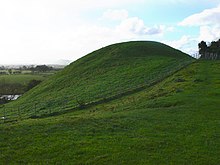Robert of Rhuddlan
Robert of Rhuddlan (also called Robert de Tilleul or de Rodelent; † 1093 at Deganwy ) was a Norman knight and adventurer who conquered large parts of North Wales.
He was a son of the Norman nobleman Humphrey of Tilleul and probably came to England before the Norman conquest , where he was knighted by King Edward the Confessor . Together with his cousin Hugh d'Avranches , he conquered Northeast Wales from Chester from 1071 . In 1071 he defeated Bleddyn ap Cynfyn , King of Powys . Around 1073 he built on the site of the residence of the Welsh king Gruffydd ap Llywelyn Rhuddlan Castle , after which he was named from then on. In 1075 he supported Gruffydd ap Cynan in his attempt to become king of Gwynedd . After Gruffydd had driven away his rival Trahern ap Caradog with Robert's help , he turned against Robert and attacked Rhuddlan Castle. The attack failed, and as a result Gruffydd had to flee Gwynedd again. With royal approval, Robert pushed further west and built Deganwy Castle on the River Conwy around 1078 . King William the Conqueror appointed Robert as the independent lord of Rhos and Rhufoniog . In 1081 Robert Gruffydd ap Cynan was captured, who had defeated and killed Carn Trahern ap Caradog in the Battle of Mynydd Carn . Robert gave Gruffydd to Hugh d'Avranches, who imprisoned him in Chester. The captivity of Gruffydd and the death of Trahern left a power vacuum in Gwynedd that Robert took advantage of. For an annual fee of £ 40 , Robert obtained permission from the King of England to attack North Wales west of the River Clwyd . Robert continued to plunder with Welsh and Norman troops into North West Wales. As a result, the Normans conquered large parts of North Wales and built castles in Bangor , Caernarfon and Aberlleiniog on the island of Anglesey .
Robert at times fell out with Hugh d'Avranches over the division of the estates, so that during the rebellion of 1088, unlike his cousin, he did not support King William II , but his brother Robert Curthose . During the rebellion, Robert and Odo von Bayeux were besieged at Rochester Castle . After the castle was conquered and the rebellion was put down, Robert was pardoned by the king.
Robert probably died in 1093 after Gruffydd ap Cynan was released from captivity. Gruffydd ap Cynan is said to have led a raid with three ships along the north Welsh coast. When the pirates brought cattle and prisoners from Robert's lands onto his ships, Robert is said to have attacked Gruffydd and his ships from Deganwy Castle only in the company of a squire. He was overwhelmed and killed. Hugh d'Avranches had him buried in St. Werburgh Abbey, now Chester Cathedral.
Robert donated part of his property in Cheshire to the Abbey of Saint-Évroult in Normandy, but ultimately they fell to the Abbey of St. Werburgh after a dispute between Hugh and Robert's brother. His lands in Wales fell to Hugh d'Avranches after his death.
Robert was seen as the model of a reckless Norman who combined ruthless carnage, pride and piety. He was less concerned with ruling the country than with fighting. Nevertheless, he had so consolidated the Norman rule over northeast Wales that the region belonged to the Earl of Chester until 1140 and was only recaptured by the princes of Gwynedd after a Welsh rebellion .
Web links
Individual evidence
- ^ Castles of Wales: Rhuddlan Castle. Retrieved June 18, 2014 .
- ^ David Walker: Medieval Wales . Cambridge University Press, Cambridge 1990, ISBN 978-0-521-31153-3 , p. 26
- ^ Rees R. Davies: The Age of Conquest. Wales 1063-1415 . Oxford University Press, Oxford 1991, ISBN 0-19-820198-2 , p. 87
- ^ Christopher Harper-Bill: Anglo-Norman studies XVII: proceedings of the Battle Conference, 1994 . Boydell, Woodbridge 1995, ISBN 978-0-85115-606-4 , p. 226
- ^ Rees R. Davies: The Age of Conquest. Wales 1063-1415 . Oxford University Press, Oxford 1991, ISBN 0-19-820198-2 , p. 30
- ^ David Walker: Medieval Wales . Cambridge University Press, Cambridge 1990, ISBN 978-0-521-31153-3 , p. 26
| personal data | |
|---|---|
| SURNAME | Robert of Rhuddlan |
| ALTERNATIVE NAMES | Robert de Tilleul; Robert de Rodelent |
| BRIEF DESCRIPTION | Norman knight and conqueror of North East Wales |
| DATE OF BIRTH | 11th century |
| DATE OF DEATH | 1093 |
| Place of death | Deganwy |
